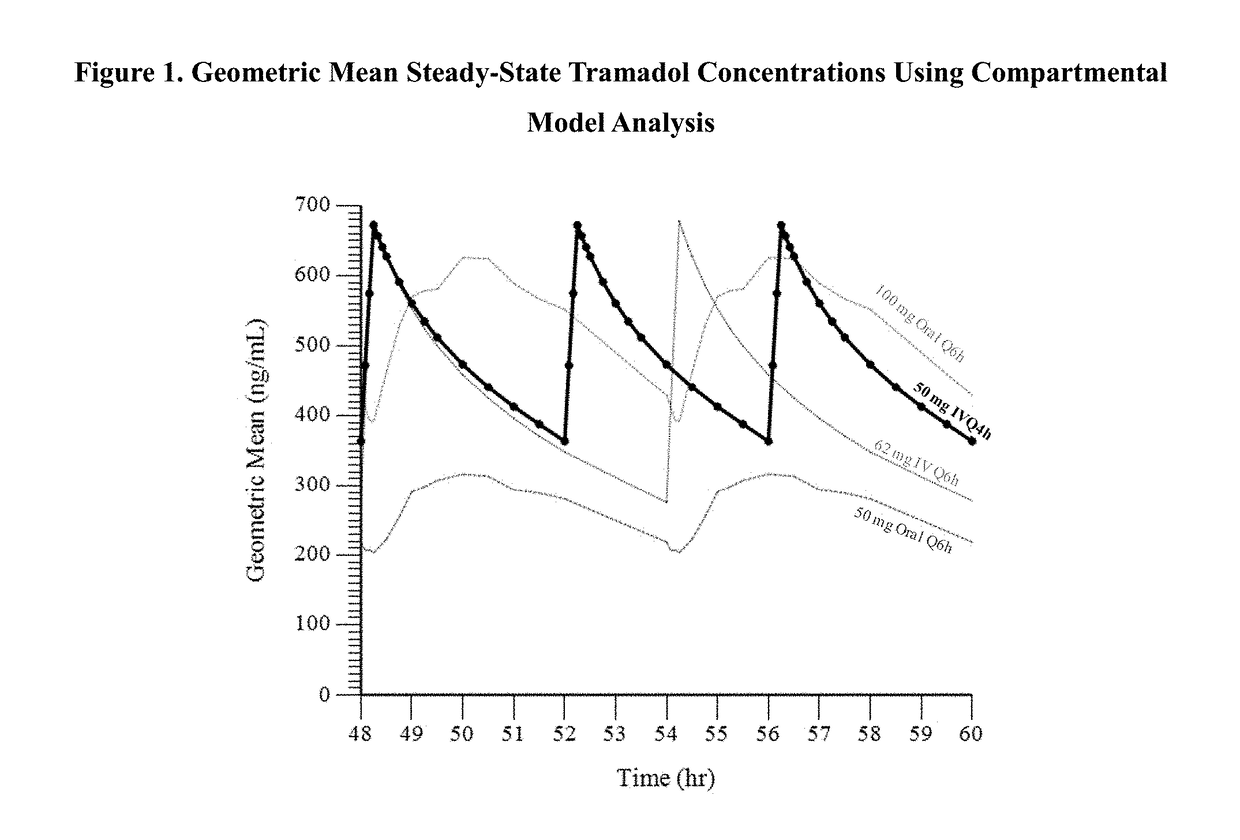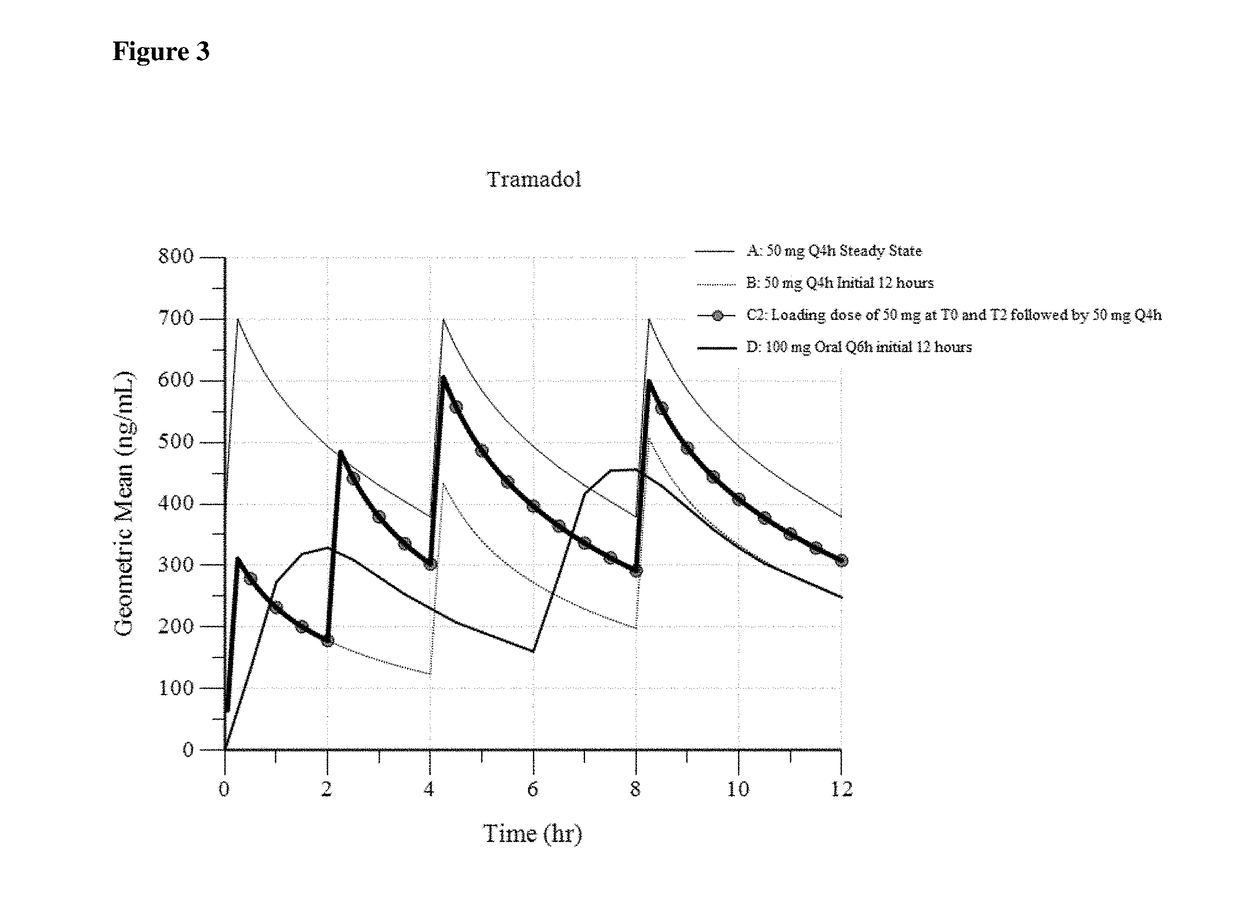Intravenous administration of tramadol
a tramadol and intravenous technology, applied in the field of tramadol intravenous administration, can solve the problems of inability to obtain the dosage form in the usa, increase the incidence of minor adverse events, and increase the consumption of tramadol, so as to improve the safety and tolerability of tramadol, and accelerate the onset of pain relief.
- Summary
- Abstract
- Description
- Claims
- Application Information
AI Technical Summary
Benefits of technology
Problems solved by technology
Method used
Image
Examples
example 1
[0134]The purpose of this analysis was to calculate the systemic exposure of tramadol and its active metabolite Ml, when given as an intravenous (IV) infusion that would provide an AUC and Cmax that are comparable to immediate release oral tramadol HCl 100 mg administered every 6 hours (e.g., Ultram® 100 mg IR q6h).
[0135]Tramadol is extensively metabolized by CYP2D6 and CYP3A4. One metabolite, Ml, is 6 times more potent than the parent compound in producing analgesia and 200 times more potent in μ opioid binding in animal model. For PK modeling purposes, tramadol level (Cmax) was considered to be the most important parameter, as it is most directly related to seizure risks. Due to first pass metabolic saturation, steady-state plasma concentration exceeds that of a single dose administration. Steady-state is reached in about 42-48 hours. For PK modeling purposes, the dose proportionality study previously reported in the assignee's U.S. Pat. No. 8,895,622 was used as basis for the mod...
example 2
[0140]In this Example, the administration of tramadol and its active metabolite M1 were evaluated using model simulated parameters, when administered as a 15-minute intravenous (IV) infusion of tramadol every 4 hours using a compartmental model previously developed to describe the pharmacokinetics of the parent drug tramadol and its M1 metabolite as administered Q6h, with the goal of the intravenous dosing regimen to provide a Cmax and AUC of tramadol which is similar to the Cmax and AUC of an oral dose of 100 mg tramadol HCl given every 6 hours. In this Example, a 48 mg IV infusion administered every 4 hours and a 62 mg IV infusion administered every 4 hours were modeled.
[0141]The geometric mean at steady-state for Cmax and AUC6 of tramadol and M1 resulting from the simulated IV infusion given Q4h at a dose of 48 mg was similar to that observed at Q6h for the 100 mg oral dose. The percent of PK value at steady-state of tramadol for the simulated IV infusion administered Q4h at 48 m...
example 3
[0144]In Example 3, three different dosing regimens were modeled based on the results in Examples 1 and 2. In Examples 3a -3c, a 50 mg intravenous tramadol dose was modeled via administration every 4 hours.
[0145]In Example 3a (“100 mg Loading Dose”), a 100 mg intravenous tramadol loading dose was first administered, and then a 50 mg intravenous tramadol dose is administered 4 hours later. Thereafter, the intravenous tramadol is administered as a 50 mg dose every 4 hours (100 mg dose, followed by 50 mg q4h).
[0146]In Example 3b (“50 mg Loading at 2 hr”), a 50 mg tramadol dose is initially administered (at 0 hours). Therefore, in this dosing regimen, a 50 mg intravenous tramadol dose is administered 2 hours after the initial 50 mg dose (as a second dose). Another 50 mg intravenous dose is administered 2 hours after the second dose. Thereafter, 50 mg intravenous tramadol is administered every 4 hours. (50 mg at T0, 50 mg at T2, followed by 50 mg at T4, T8 . . . ).
[0147]In Example 3c (“1...
PUM
| Property | Measurement | Unit |
|---|---|---|
| Time | aaaaa | aaaaa |
| Time | aaaaa | aaaaa |
| Time | aaaaa | aaaaa |
Abstract
Description
Claims
Application Information
 Login to View More
Login to View More - R&D
- Intellectual Property
- Life Sciences
- Materials
- Tech Scout
- Unparalleled Data Quality
- Higher Quality Content
- 60% Fewer Hallucinations
Browse by: Latest US Patents, China's latest patents, Technical Efficacy Thesaurus, Application Domain, Technology Topic, Popular Technical Reports.
© 2025 PatSnap. All rights reserved.Legal|Privacy policy|Modern Slavery Act Transparency Statement|Sitemap|About US| Contact US: help@patsnap.com



